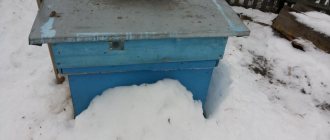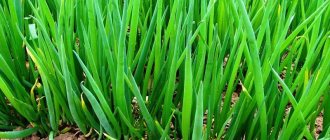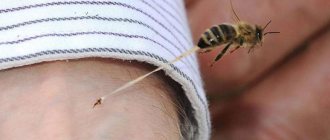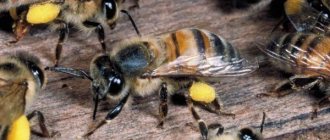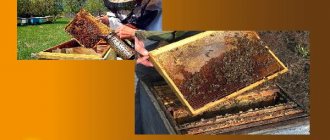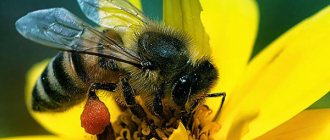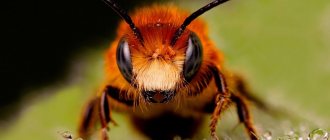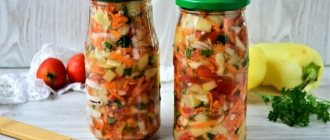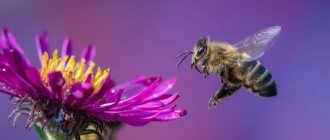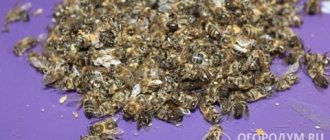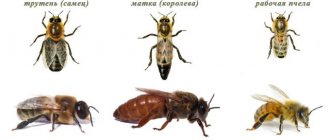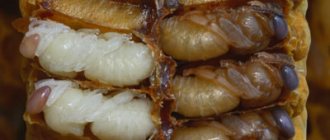- Blog articles
- Bees
Beekeeping
Economics of beekeeping
Beekeeping news in Russia
Beekeeping news in the world
Honey
Propolis
Bee bread
Zabrus
Royal jelly
In the world about bees
Apiary
Bees
News from honey fairs
From the history of beekeeping
- Preparing bees for winter
- Correct assembly of a bee nest for the winter by a beekeeper
- Nutrition of bee colonies in winter
- Feeding bees in winter
- Wintering bees in a hive outside
- Wintering of bees in omshanik
- Temperature in a bee club in winter
- Insulation and ventilation of a bee nest
- Principles for successful wintering
- Control of wintering of bees
- Video recommendations and tips for preparing bees for winter
Preparing bees for winter
Bees, unlike many other insects, do not hibernate in winter. As soon as they feel a natural stable drop in temperature and a decrease in daylight hours, they go into food saving mode. Moreover, they gradually expel the drones from the hive, since the queens are already inseminated. This behavior is explained by the fact that winter food reserves need to be made, but drones eat more food than bees.
Insects begin to prepare the honeycombs in the hive in a certain way. Nectar that is considered immature is transferred upward for ripening. Honey is also transferred to the upper part of the frames and is gradually filled from the top bar to the bottom and sides of the nesting frame. A winter club will subsequently be formed in the area cleared of brood. In general, the behavior of bees becomes more wary and aggressive. All their actions are aimed at preserving bees and food for the whole winter.
What and how to feed bees?
First of all, bees should receive natural honey, but if there is not enough of it or it is of poor quality, the food is replaced with other food.
Sugar syrup
This food does not contain vitamins and microelements, but it is possible to maintain the vitality of bees. In addition, it will warm the hive.
How to cook:
- Use enamel cookware, but not iron, to prevent oxidation.
- Pour in 2 liters of water, boil for 5 minutes.
- Remove from heat and add 3.5-4 kg of sugar.
- Stir thoroughly until the sugar is completely dissolved.
- Cool until warm.
- Add vinegar essence (approximately 1.2-1.3 ml per 4 kg of sugar), but this is not necessary.
Feeding rules:
- For 1 hive per day you need approximately 5 liters of syrup.
- Feeding time is evening.
- The state of the syrup is warm (hot and cold are excluded).
- If the bees are completely restored, the dosage is reduced to 300 ml.
- The hive must be well ventilated, otherwise condensation will be created, leading to a deterioration in the condition of the insects.
Syrup with potatoes
By adding potato juice, you can significantly improve the composition of the syrup, saturating it with useful substances.
Cooking method:
- Peel the potatoes, rinse thoroughly;
- pass the tubers through a meat grinder or grate on the finest grater;
- squeeze out the juice;
- For 1 liter of sugar syrup, add a maximum of 60 ml of juice;
- Dilute components only when warm.
How to feed:
- tie the container that you will place in the hive with gauze;
- pour the mixture into this glass container;
- put in the hive;
- Make sure that the bees not only drink the juice and syrup, but also eat the starch residue.
Dough made from sugar and honey
This recipe is used as a top dressing. Used and prepared as follows:
- take 4 kg of granulated sugar, grind it with a blender to powder;
- put a kilogram of honey on the fire (it should become liquid and warm);
- add powdered sugar, stir;
- achieve dough consistency;
- add 100 ml of water;
- make a flat cake 2 cm thick from half a kilogram of dough;
- place the dough on the frame.
Fertilizing with beebread
You can feed beebread in 2 ways:
- Bees place bee bread on the sides of the brood, that is, on the edge of the honeycomb. When the pollen flow is in full swing, you need to remove these honeycombs and install frames with foundation in their place. And the beebread elements are installed in another housing, which will allow insects to fill them with honey and seal them. After this, take out the frames and place them in boxes, the temperature in which should be from 2 to 8 degrees. At the beginning of spring, feeding is carried out (when the bees need to gain strength).
- Preservation of bee bread. It is necessary to remove the surface of the cells on which there is beebread with a sharp knife. Next, they are cut and passed through a meat grinder. Afterwards, wash the glass jars and dry thoroughly. Place beebread in them and fill them with honey. Roll up in the usual way. When feeding is carried out, the jars are placed in warm water so that the mass melts and becomes homogeneous. Place 300-400 grams of the product on polyethylene, which is turned over onto the frames and left as insulation. You can repeat fertilizing after 7-10 days.
You will find more information about feeding bees in this article.
Correct assembly of a bee nest for the winter by a beekeeper
In home apiary conditions, families are fed throughout the cold season with honey prepared in advance or processed sugar syrup, since beekeepers take commercial honey. Accordingly, part of the honeycomb becomes unnecessary for the bees. From here the desired amount of food for the winter per family is calculated. If this is not done, the bees will form a winter club on completely empty combs, which will lead to the death of the colony in winter.
The nest is assembled depending on the strength of the family itself and the type of hive. If the family is strong, then it is assembled in an “arch”. Those. heavy-weight frames are placed on the sides, and less heavy ones (up to 2-2.5 kg) are placed closer to the center. In this case, an additional frame with food is placed in the very center (above the wintering club of bees). If the family is of average strength, then the food supply in the nest is placed at an angle. The arrangement of the remaining frames is in descending order from the sides. When weak, heavy frames are placed in the center, and less heavy frames are placed on the sides. This type of nest is called a "beard".
It is also necessary to pay special attention to ventilation. In the winter club, the bees move upward, since all the food is there. These movements are slow but constant. If the frames on which the bees were placed are eaten, then there is a very small chance that they will end up on the next full-sized one.
A particular danger is when a winter club can split into two parts during the winter. This can happen when the beekeeper mistakenly formed the nest so that the frames without honey, but with brood, ended up in the center. The frames will subsequently be freed from brood and will turn out to be completely empty, which is why the club may collapse. To prevent this, full honeycombs are placed outside the outer limits of the nest's honeycombs, and empty ones take their places with the obligatory feeding of the bees.
Autumn revision
An autumn check of the bee colony is necessary so that all worker bees are strong, hardy and healthy by spring. Undoubtedly, active measures should be carried out throughout the entire honey collection, but inspection before winter is an integral part of correct and timely preparation for winter. To be more precise, this is the very first stage. During the work, shortcomings are identified that may interfere with successful wintering.
The beekeeper must take into account the following nuances:
- To estimate the number of young worker bees, thanks to which the whole family will survive during cold weather, the number of brood is taken into account.
- The most important point is the age of the queen bee, since the ability to sow brood depends on this. Accordingly, the number of the whole family increases.
- Qualitative indicators of feed reserves - honey and bee bread. If their quality or quantity does not meet the requirements, the bee family will be weakened and many individuals will die.
- The condition of worker bees – their activity, performance, presence of diseases.
- Suitability of honeycombs for wintering.
To evaluate all the nuances, the beekeeper must carefully examine the hives and insects. The inspection is carried out under favorable weather conditions, since otherwise the habitual mode of life for bees is disrupted.
Nutrition of bee colonies in winter
You should start preparing honey in mid-summer, when the honey harvest is in full swing. To prepare bee colonies, be sure to use only dark-colored honeycombs. Because they are the warmest. A complete seal of the combs is desirable, i.e. All honeycombs must be covered with wax caps. This is the best protection for honey from moisture or too dry air.
There are times when the honey harvest is interrupted due to weather conditions and timely procurement of honey by bees is impossible. Then feeding comes to the rescue. It serves as thick sugar syrup. It is made in large portions, pouring 5-10 liters at a time into large feeders. This is what distinguishes spring feeding from autumn feeding; in the spring, bees are given 0.5-1 liters of feeding.
Honey plants
This is the name given to flowering plants from which bees collect pollen or nectar. How the insects themselves figure this out is unknown to science. From linden and buckwheat, for example, bees collect only nectar, and from corn, poppy, and alder - pollen. But some types of plants have a universal purpose: insects collect both from them. Examples are red clover, field dandelion, and sunflower.
An interesting fact is that bees will not collect nectar from honey plants that are not native to the area. To put it simply, it can be said this way: in Siberia, for example, honey cannot be made from orchids, just as in Brazil it is impossible to make honey from linden or acacia.
Video: Winter inspection of bees
How the frames with honeycombs will be installed depends on the structure of the hive. The frames can be installed on warm and cold drift, i.e. parallel or perpendicular to the hive entrance. The amount of required food supplies depends on how the winter hut is planned. If wintering takes place in warmer conditions (for example, an insulated barn, omshanik, cellar) at a temperature of +2-4C degrees, then about 8-10 kg of honey will be needed in reserves. But if the temperature at which the family will winter is around or below -20C degrees, then up to 14-20 kg of feed will be required.
Bee nutrition in summer
What does a bee eat? In the warm season, nectar is the food. If there are no honey plants nearby, the bees will urgently search for a new source of food. In the forest, the search for honey plants is limited to a radius of two to three kilometers, if the area is open - a little more. At this time, communication occurs between the bees. To do this, they use signs that they draw in flight.
It is very important in the summer to take care of the choice of honey plants. It is necessary that they contain less sucrose and glucose, since these compounds significantly accelerate the crystallization of honey. What can happen is that if there is enough honey collected by bees, insects often starve to death as it turns into crystals. It is important to know: in the nectar of sunflower, heather, cotton, rapeseed, mustard, glucose and sucrose are found in large quantities.
Wintering bees in a hive outside
This type of winter quarters is called “in the wild.” In order for families to survive the winter well, a number of conditions must be met:
- hives must be of good quality and insulated;
- ensure that mice or other pests cannot enter;
- the entrances are set up to the south;
- Only strong families should winter outside (if possible, the weak should be moved in with the strong);
- providing a sufficient supply of feed (at least 25 kg);
- All hives should be kept strictly under snow.
The disadvantages include the fact that you will need a large amount of food, you will need protection from birds, and you must also monitor the level of snow in the apiary. One of the advantages is that no special structure is required, there is no need to move families. In bees that winter in the wild, spring development begins faster.
Wintering of bees in omshanik
The most important thing when wintering in Omshanik like this is to observe the temperature regime of about +1..+3C degrees, and humidity (60-80%). All this can be ensured by good natural or artificial ventilation. Only when the temperature is very low for a long time can you use a thermostat. One of the obvious advantages is that much less feed is required compared to other wintering methods. Also, being in the omshanik, the hives are relatively safe, and it is also easier to conduct winter inspections of the colonies.
Of the minuses, the most significant is that the omshanik needs to be built, spending significant finances, and it occupies a fairly large area of your apiary. A rare disadvantage may be that in the event of a strong increase in temperature inside the omshanik, it can be very difficult to lower the temperature. It is definitely recommended to use thermometers with hygrometers to monitor indoor temperature and humidity.
Treatment of bees and hives against diseases
Bees are quite often exposed to diseases that can lead to their death during wintering. Therefore, it is important to treat insects and hives in preparation. This is done after the last brood has appeared and the nest has formed. The most common diseases are nosematosis and varroatosis.
There are different processing methods:
- Complementary feeding with medicines. That is, the appropriate medicine is injected into the liquid food (preferably sugar syrup). Bees eat it along with their food. The veterinarian must choose the drug based on the expected disease, although there are universal remedies. For nosematosis, Fumagilin proved to be effective, and for varroatosis, Apimax.
- Smoke cannon. To do this, smoke is introduced into the hive, closed for 20 minutes, and then opened. The downside is the need to carry out the procedure twice. Today there are special preparations that treat the hive thermally using a special gun. You can fumigate hives with Folbex, Phenothiazine, Bipin.
- Liquid vapor. To do this, you need to hang a plate in the hive, onto which a liquid product is first applied. The bees touch it and spread the drug throughout the hive, creating a chain reaction effect. Or vapors are released from the plate, which the bee absorbs through the respiratory tract. Products: Nosemaline, oxalic acid.
Some chemicals have a negative effect on the family. Therefore, choose products based on natural ingredients.
Temperature in a bee club in winter
The number of degrees inside the club does not depend on external data. Studies have shown that in 24 hours it can change from 19-25 degrees to 29-35 degrees. This is due to the feeding and movement patterns of bees. The colder the air outside, the more intensively the bees have to feed and move.
Bees do not sleep in winter. Their biological processes slow down, the need for food becomes low, and the excretory system does not work at all. They are constantly in slow motion. One bee is not able to maintain the required temperature, which is why they are forced to exist in families. At the same time, it is obvious that the larger the bee colony, the easier it is for it to maintain the desired temperature inside the club throughout the winter.
Insulation and ventilation of a bee nest
These are essential procedures, since the cold can kill entire families at once, and the lack of ventilation leads to dampness. Dampness is very harmful to insects. The walls of the hive become damp and mold may appear; due to increased humidity, the honey may sour. Bad honey causes diarrhea in bees. After this, wintering usually ends very sadly, up to complete death, or the bee colonies emerge in the spring very worn out and will not be able to fully develop.
Insulation is carried out using wooden diaphragms or other insulation materials (moss, tow, straw). Many beekeepers use insulating pillows. The most effective method of ventilation is considered to be ceiling ventilation. Ventilation can also be enhanced by either opening the entrances from time to time or keeping them open throughout the winter. It is advisable to ensure that the nest is ventilated from different sides; for this, you can install a metal grille in the bottom of the hive.
Important! When using any type of insulation, remember that it is equally important to ensure proper ventilation!
Bee family
Its composition was studied by Aristotle. In the process of learning, he had to admit that there are three types of bees: the female queen, male drones and worker bees, which are also females, but without genetic research at that time it was impossible to determine this.
Colony strength depends on the number of worker bees that are counted in the spring. A family containing from 25 to 80 thousand “hard workers” is considered strong. Each family member has a specific function. For example, the queen only bears offspring, the drones mate with her, and worker bees provide the life of the family. The composition of the bee colony does not change from autumn (October) to spring (April). But from May to June, the number of the family increases due to the appearance of a large number of drones, approximately 5-6% of the total number of insects. Since July there have been fewer of them. If the family lacks food, it gets rid of the drones and their brood. It happens that a bee colony completely leaves the hive. Inexperienced beekeepers believe that this is due to the swarming instinct or lack of nutrition. But it is not so. This phenomenon is typical for bees when honeycombs in the hive are damaged.
Principles for successful wintering
In order for bees to successfully overwinter, it is advisable to create favorable conditions:
- the most important thing is to provide families with the right amount of food;
- depending on the wintering method, it is necessary to carefully prepare the hives or the premises in which they will be located;
- take care of insulation;
- monitor the humidity level in the hive;
- think over the ventilation of the bees' nest;
- provide families with complete peace and quiet
- hives should be protected from mice and birds entering them.
- protect the hive from direct sunlight.
Preparing the hive
One of the main enemies for insects is the wind. Therefore, you need to take care of the tightness of the hive. At the end of summer, beekeepers usually insulate the bee house externally and internally. Virtually any construction waste, such as polystyrene foam, plastic, pieces of polystyrene, or foil, is suitable for this.
The hive cover is insulated thanks to a fabric or felt construction. It is better to use natural materials, such as cotton or linen fabrics. It is not advisable to use synthetic winterizer for insulation, as bees can simply get entangled in it and die.
The hive is cleaned of dirt and old honeycombs. The lower sector of the honeycomb is removed, which allows optimizing the living space for wintering bees. All bee houses are placed on the south side. This allows you to receive an additional source of sunlight.
There is no need to seal the hive, as the bees will need ventilation anyway. To do this, you can drill small holes directly into the roof of the hive. Usually, two or three small holes are enough for bees to function normally. Such holes will help avoid excessive condensation, which can provoke the development of mold in the hives.
Control of wintering of bees
Winter bee inspections are best done when the air is not very cold. The hive quickly and quietly opens and determines where the winter club is located. If it is below, this means that wintering is going well. If it is at the top, this indicates that the food is running low and additional food or a frame of honey needs to be added. The cause of restlessness among bees and increased noise coming from the hive is often a lack of food. Accordingly, families should be fed. And if mold is found in the hive, then immediately remove the insulation and increase ventilation.
When controlling bees in the winter hut, it is necessary to use only red light, since sunlight and white light have an exciting effect on them and they can fly out of the hive. It is necessary to act without noise or sudden movements, so as not to disturb the family.
The success of wintering can be assessed by the amount of death. If there is not too much of it, then everything is fine. If there is a lot of waste, then it must be removed from the bottom with a special scraper. It is worth paying attention to the moisture content of the deadstock; if wintering is successful, it should be as dry as possible.
When it gets warmer outside, the hives need to be moved overnight to the places where they were in the summer. In this case, it is useful to replace the donya with new ones. Because it is located on old bottoms, one can judge how the insects overwintered.
The presence of a hum or noise inside the hive indicates problems in the club. These may be high temperatures, high humidity or lack of food. When wintering is successful, the bees inside sit quietly and calmly and do not make any increased hum or noise.
Why do bees die in winter?
Mortality is influenced by various factors, including poor wintering. The right content will help minimize or completely eliminate:
- weak families;
- death of the uterus;
- hunger;
- high humidity;
- low temperature;
- diarrhea;
- illness;
- rodents.
Excessive moisture is determined by the presence of mold. The main factor is insufficient ventilation of the omshanik. Improper treatment against diseases also increases humidity levels.
The formation of excess moisture leads to souring of honey. The consequences are the death of insects due to hunger. There may be a shortage of food due to crystallization of honey and cold.
A common consequence of death may be bee diarrhea. When brood appears in the last months of autumn, proper flight does not occur. A large amount of feces accumulates. A full intestine of young individuals leads to pestilence of the entire family.
Honeydew honey can also cause diarrhea. Honey varieties with the highest content of active ingredients are not suitable for eating during the wintering period. These include all varieties of dark colors. It crystallizes and sours faster.
The absence of a uterus is another pestilence factor. When the bees search for the queen, the state of the club is disrupted. The insects can no longer gather again, and a steady death occurs.
Smooth death is caused by increased temperature in the house, eight degrees or excessive noise and bright light.
The slide-shaped podmor says that the bees were not warm enough, and the cause of death was starvation. While moving for food, several small tubers may form.
The cause of bee death is infectious and invasive diseases. Some of them:
- viral paralysis;
- salmonellosis;
- calcareous, sacbrood;
- rotting larvae.
When eliminating diseases, special treatment is carried out. It is necessary to combat pathogens correctly so that this does not become another reason for the death of bees.
